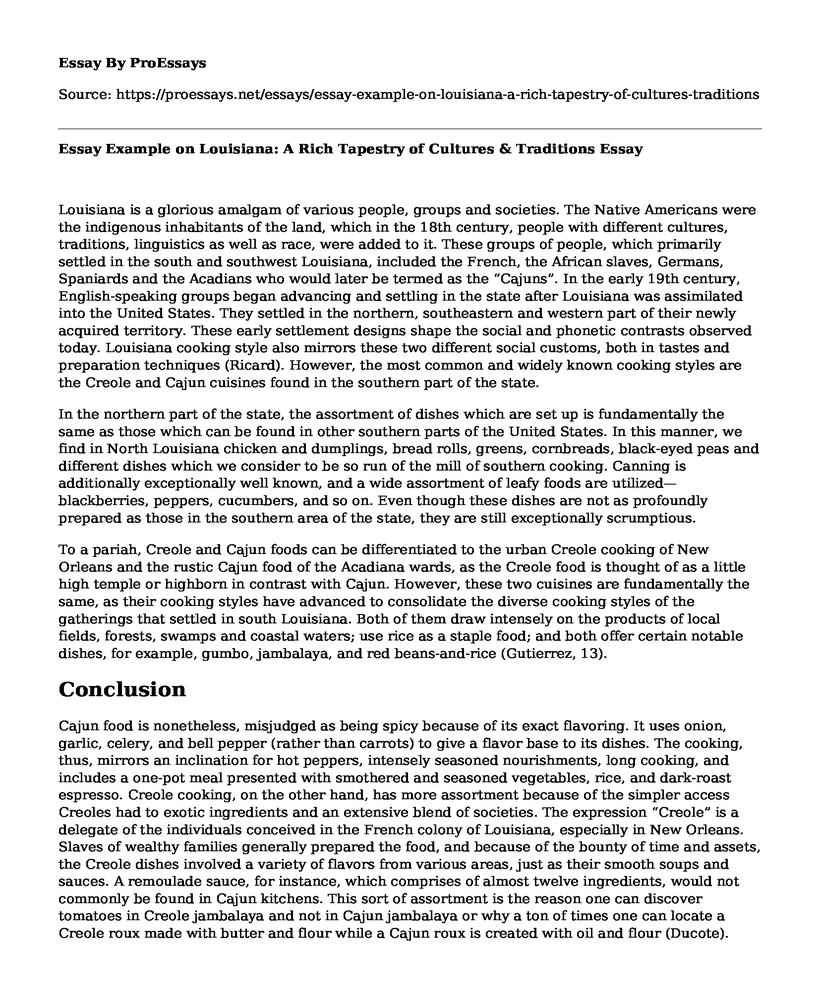Louisiana is a glorious amalgam of various people, groups and societies. The Native Americans were the indigenous inhabitants of the land, which in the 18th century, people with different cultures, traditions, linguistics as well as race, were added to it. These groups of people, which primarily settled in the south and southwest Louisiana, included the French, the African slaves, Germans, Spaniards and the Acadians who would later be termed as the “Cajuns”. In the early 19th century, English-speaking groups began advancing and settling in the state after Louisiana was assimilated into the United States. They settled in the northern, southeastern and western part of their newly acquired territory. These early settlement designs shape the social and phonetic contrasts observed today. Louisiana cooking style also mirrors these two different social customs, both in tastes and preparation techniques (Ricard). However, the most common and widely known cooking styles are the Creole and Cajun cuisines found in the southern part of the state.
In the northern part of the state, the assortment of dishes which are set up is fundamentally the same as those which can be found in other southern parts of the United States. In this manner, we find in North Louisiana chicken and dumplings, bread rolls, greens, cornbreads, black-eyed peas and different dishes which we consider to be so run of the mill of southern cooking. Canning is additionally exceptionally well known, and a wide assortment of leafy foods are utilized— blackberries, peppers, cucumbers, and so on. Even though these dishes are not as profoundly prepared as those in the southern area of the state, they are still exceptionally scrumptious.
To a pariah, Creole and Cajun foods can be differentiated to the urban Creole cooking of New Orleans and the rustic Cajun food of the Acadiana wards, as the Creole food is thought of as a little high temple or highborn in contrast with Cajun. However, these two cuisines are fundamentally the same, as their cooking styles have advanced to consolidate the diverse cooking styles of the gatherings that settled in south Louisiana. Both of them draw intensely on the products of local fields, forests, swamps and coastal waters; use rice as a staple food; and both offer certain notable dishes, for example, gumbo, jambalaya, and red beans-and-rice (Gutierrez, 13).
Conclusion
Cajun food is nonetheless, misjudged as being spicy because of its exact flavoring. It uses onion, garlic, celery, and bell pepper (rather than carrots) to give a flavor base to its dishes. The cooking, thus, mirrors an inclination for hot peppers, intensely seasoned nourishments, long cooking, and includes a one-pot meal presented with smothered and seasoned vegetables, rice, and dark-roast espresso. Creole cooking, on the other hand, has more assortment because of the simpler access Creoles had to exotic ingredients and an extensive blend of societies. The expression “Creole” is a delegate of the individuals conceived in the French colony of Louisiana, especially in New Orleans. Slaves of wealthy families generally prepared the food, and because of the bounty of time and assets, the Creole dishes involved a variety of flavors from various areas, just as their smooth soups and sauces. A remoulade sauce, for instance, which comprises of almost twelve ingredients, would not commonly be found in Cajun kitchens. This sort of assortment is the reason one can discover tomatoes in Creole jambalaya and not in Cajun jambalaya or why a ton of times one can locate a Creole roux made with butter and flour while a Cajun roux is created with oil and flour (Ducote).
Works Cited
Ducote, Jay. Cajun vs. Creole Food- What is the difference. Lousiana Travel. Retrieved on 13th June 2020, from https://www.louisianatravel.com/articles/cajun-vs-creole-food-what-difference
Gutierrez, Charlotte. Louisiana’s Traditional Foodways. Folklife-media. 1985. Retrieved on 13th June 2020, from https://folklife-media.si.edu/docs/festival/program-book-articles/FESTBK1985_05.pdf
Ricard, Ulysses. Lousiana Cooking: A Way of life. Louisiana Folklife. 1987. Retrieved on 13th June 2020, from http://www.louisianafolklife.org/LT/Articles_Essays/creole_art_cooking_life.html
Cite this page
Essay Example on Louisiana: A Rich Tapestry of Cultures & Traditions. (2023, Aug 29). Retrieved from https://proessays.net/essays/essay-example-on-louisiana-a-rich-tapestry-of-cultures-traditions
If you are the original author of this essay and no longer wish to have it published on the ProEssays website, please click below to request its removal:
- History of Christianity in Hui Research
- How the Eastern Invention Influenced the Japanese Gender Roles Paper Example
- Prince Henry Essay Example
- Essay Example on Women in Agriculture: A Growing Concern
- Essay Example onToyota Motor Manufacturing Canada: Canada's Auto-Making Powerhouse
- Essay Example on Chinese Yuan Joins Global Currencies, Post-Economy Liberalization
- Paper Sample on Racism in US: A Legacy of Colonialism & Inequality







